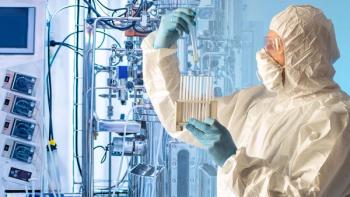
- BioPharm International-11-02-2012
- Volume 2012 Supplement
- Issue 2
Upstream, Downstream Processing in Motion
GE Healthcare Life Sciences' ReadyToProcess platform aims to streamline bioprocessing.
The need to streamline operating costs in biopharmaceutical processing applications has encouraged several companies to shift gears to the open road of innovation. At the same time, the uncertain economic climate has rendered the demand curve of the aforementioned more inelastic. GE Healthcare Life Sciences has been promoting its ReadyToProcess platform via a truck tour that's inclusive of a 1000-ft2 mobile suite containing the company's single-use bioreactors, filters, tubing and connectors, chromatography systems, and columns—all preconditioned, ready to plug in, and use.
The platform, available globally, incorporates both upstream and downstream steps, including chromatography systems that use fully disposable single-use flow paths, prepacked and prequalified chromatography columns, single-use bioreactors, and tangential flow filtration products for ultrafiltration–difiltration and cell harvest applications. The support pieces that make everything work are also part of the platform, such as sterile filter assemblies, aseptic tube welders, and sealers as well as disposable, genderless, aseptic connectors. BioPharm International spoke with Matthew Stortz, senior manager, marketing operations, and Lorraine F. Attridge, business leader, ReadyToProcess, of GE Healthcare Life Sciences to gain an inside look on how the platform serves to meet the need of making bioprocessing applications more efficient.
BioPharm: When was the ReadyToProcess platform issued and what has been the progression of its development?
Stortz: The platform has been growing steadily sinceits official launch on Oct. 1, 2007. GE Healthcareacquired WAVE Biotech on Apr. 16, 2007, and usedits product portfolio of single-use bioreactors, mixers,and aseptic tube fusers and sealers, as well asconsumable bags, in addition to internally developedfiltration products (e.g., TFF, normal flow filtration [NFF]) as the basis for the ReadyToProcess platform. In December 2008, the ÄKTA ready disposable flowpath chromatography system was launched and can be used with the ReadyToProcess prepacked/presanitized chromatography columns or other conventional chromatography columns. Additional products, including ReadyMate, our Disposable Aseptic Connector, ReadyCircuit (bag and tubing assemblies facilitating interconnection of unit operations as well as filtration applications) and accessories such as ReadyKart have filled out the platform.
The most recent significant addition has been the acquisition of Xcellerex on May 10, 2012. Xcellerex provides single-use large scale stirred tank Bioreactors and mixers, complementing the WAVE Bioreactor line which currently meets a strong seed-train need. In completing this acquisition, we have filled what was perceived to be a large gap in our offering (i.e., being able to offer single-use, cell-culture capability to a 2000-L scale). Xcellerex also has strong facility design and services capabilities, which have added to our overall offering in this market.
BioPharm: What specific industry need contributed to the idea to develop this platform?
Stortz: The primary drivers forthe need of single-use/disposable technologies were costs and time savings through increased footprint utilization for multiproduct facilities and rapid turnaround between bioprocessing campaigns. It was unusual to see an industry prudently resistant to disruptive technology adopt and shift in such a short time to single-use/disposable technologies throughout the upstream and downstream unit operations. GE Healthcare Life Sciences identified this trend early and built a portfolio to meet the market needs through organic product development as well as by acquiring technologies which could serve to provide an end-to-end solution with easily adoptable unit operations interfacing with competitor single-use platforms or for hybrid applications (i.e., mixing stainless-steel infrastructure processing skids with single-use polymer technologies).
BioPharm: What have been some of the challenges associated with the platform thus far?
Stortz: Deciding on single-use versus disposable technologies was a challenge. Certain unit operations such as NFF had seen single-use products in bioprocessing as accepted practice for many years. In traditional chromatography applications, however, it was difficult for most end users to consider using a column and system flow path once with product and then disposing of them. While there were many advantages to not needing to perform cleaning validation on a prepacked, presanitized chromatography column and an entire system flow path, it became clear that many of our customers would prefer to run multiple cycles for the same product before discarding. To support our customers’ use of a product in a manner that was not originally anticipated by us as the manufacturer, we needed to perform extensive product cycling testing to give customer the confidence to proceed with using these products for multiple processing runs and cleaning cycles.
BioPharm: What are the next steps for the platform; are there any upgrades, different models, or other changes planned?
Attridge: The ReadyToProcess Platform has been evolving over the past five years, and we fully expect that it will continue to do so as the industry continues to further adopt single-use/disposable technologies. Our strategy will continue to be to seek opportunities in areas where we can enhance our capabilities with respect to satisfying our customers’ needs, not only from an equipment or unit operations perspective, but also looking at services and tools that will be in greater demand with the broadened use of single-use/disposables across the manufacturing process.
Articles in this issue
about 13 years ago
Implementing a Single-Use TFF System in a cGMP Biomanufacturing Facilityabout 13 years ago
Development of a Full Process Train, Single-Use Facilityabout 13 years ago
Analyzing the Best Fit for a Facilityabout 13 years ago
Aligning Manufacturing and Business Strategies with Single-Use Systemsabout 13 years ago
The Challenges of Adopting Single-Use TechnologyNewsletter
Stay at the forefront of biopharmaceutical innovation—subscribe to BioPharm International for expert insights on drug development, manufacturing, compliance, and more.





